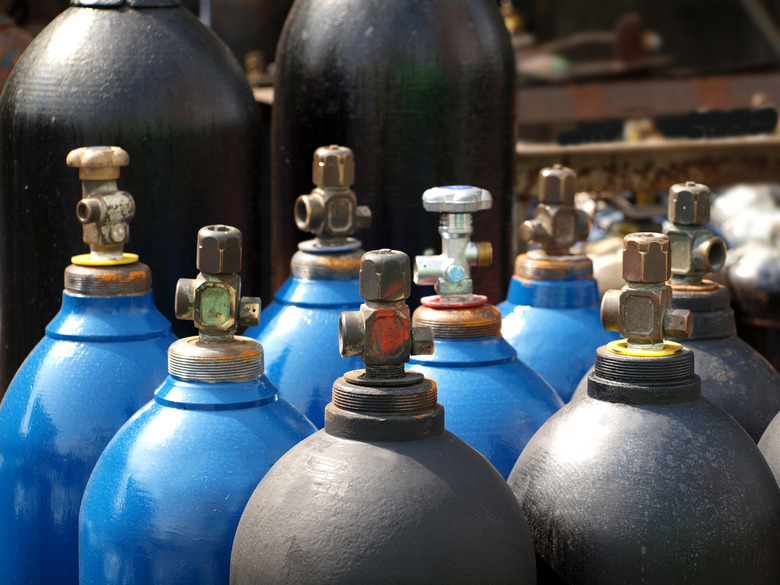What Happens To The Volume Of A Gas During Compression?
Compressing a gas initiates changes in its characteristics. Because you're compressing it, the volume of space the gas occupies decreases, but a lot more happens than this alone. Compression changes the temperature and pressure of the gas too, depending on the specifics of the situation. You can understand the changes that occur using an important law in physics called the ideal gas law. This law simplifies the real-life process somewhat, but it is useful in a wide range of situations.
TL;DR (Too Long; Didn't Read)
During compression, the volume (_V_) of a gas decreases. When this happens, the pressure (_P_) of the gas increases if the number of moles (_n_) of gas remains constant. If you keep the pressure constant, reducing the temperature (_T_) also causes the gas to compress.
The ideal gas law is the key piece of information needed to answer questions related to the expansion or compression of a gas. It states: _PV_ = _nRT_. The quantity _R_ is the universal gas constant and has the value _R_ = 8.3145 J / mol K.
The Ideal Gas Law Explained
The Ideal Gas Law Explained
The ideal gas law explains what happens to a simplified model of a gas in a range of situations. Physicists call a gas "ideal" when the molecules that it's composed of don't interact beyond bouncing off one another like little balls. This doesn't capture the precise picture, but for most situations that you encounter, the law makes good predictions regardless. The ideal gas law simplifies an otherwise complicated situation, so it's easy to make predictions about what will happen.
The ideal gas law relates the temperature (T), the number of moles of the gas (n), the volume of the gas (V), and the pressure of the gas (P) to one another, using a constant called the universal gas constant (R = 8.3145 J / mol K). The law states:
_PV_ = nRT
TL;DR (Too Long; Didn't Read)
To use this law, you state the temperatures in Kelvin, which is easy because 0 degrees C is 273 K, and adding an extra degree just increases the temperature in Kelvin by one. Kelvin is like Celsius except -273 degrees C is the starting point of 0 K.
You also need to express the amount of gas in moles. These are commonly used in chemistry, and one mole is the relative atomic mass of the gas molecule but in grams.
Compressing an Ideal Gas
Compressing an Ideal Gas
Compressing something reduces its volume, so when you compress a gas, its volume decreases. Rearranging the ideal gas law shows how this affects other characteristics of the gas:
_V_ = nRT / P
This equation is always true. If you compress a fixed number of moles of gas, and you do this in an isothermic process (one that stays at the same temperature), the pressure must increase to account for the smaller volume on the left of the equation. Similarly, when you cool a gas (reduce T) at a fixed pressure, its volume decreases – it compresses.
If you compress a gas without constraining the temperature or pressure, the ratio of temperature to pressure has to decrease. If you're ever asked to work out something like this, you'll probably be given more information to make the process easier.
Changing the Pressure of an Ideal Gas
Changing the Pressure of an Ideal Gas
The ideal gas law reveals what happens when you change the pressure of an ideal gas in the same way the law did for the volume. However, using a different approach shows how the ideal gas law can be used to find unknown quantities. Rearranging the law gives:
_PV_ / T = nR
Here, R is a constant and if the amount of gas stays the same, so is n. Using subscripts, you label the starting pressure, volume and temperature i and the final ones f. When the process finishes, the new pressure, volume and temperature are still related as above. So you can write:
_Pi Vi_ / _Ti_ = nR = _Pf Vf_ / _Tf_
This means:
_Pi Vi_ / _Ti_ = _Pf Vf_ / _Tf_
This relationship is useful in many situations. If you're changing the pressure but with a fixed volume, then _Vi_ and _Vf_ are the same, so they cancel, and you're left with:
_Pi_ / _Ti_ = _Pf_ / _Tf_
Which means:
_Pf_ / _Pi_ = _Tf _ / _Ti_
So if the final pressure is twice as big as the initial pressure, the final temperature has to be twice as big as the initial temperature too. Increasing the pressure increases the temperature of the gas.
If you keep the temperature the same but increase the pressure, the temperatures cancel instead, and you're left with:
_Pi Vi_ = _Pf Vf_
Which you can rearrange:
_Pi _/ _Pf_ = _Vf_ / _Vi_
This shows how changing the pressure affects a certain amount of gas in an isothermal process with no constraints on volume. If you increase the pressure, the volume decreases, and if you decrease the pressure, the volume increases.
Cite This Article
MLA
Johnson, Lee. "What Happens To The Volume Of A Gas During Compression?" sciencing.com, https://www.sciencing.com/what-happens-to-the-volume-of-a-gas-during-compression-13710237/. 9 March 2018.
APA
Johnson, Lee. (2018, March 9). What Happens To The Volume Of A Gas During Compression?. sciencing.com. Retrieved from https://www.sciencing.com/what-happens-to-the-volume-of-a-gas-during-compression-13710237/
Chicago
Johnson, Lee. What Happens To The Volume Of A Gas During Compression? last modified March 24, 2022. https://www.sciencing.com/what-happens-to-the-volume-of-a-gas-during-compression-13710237/
